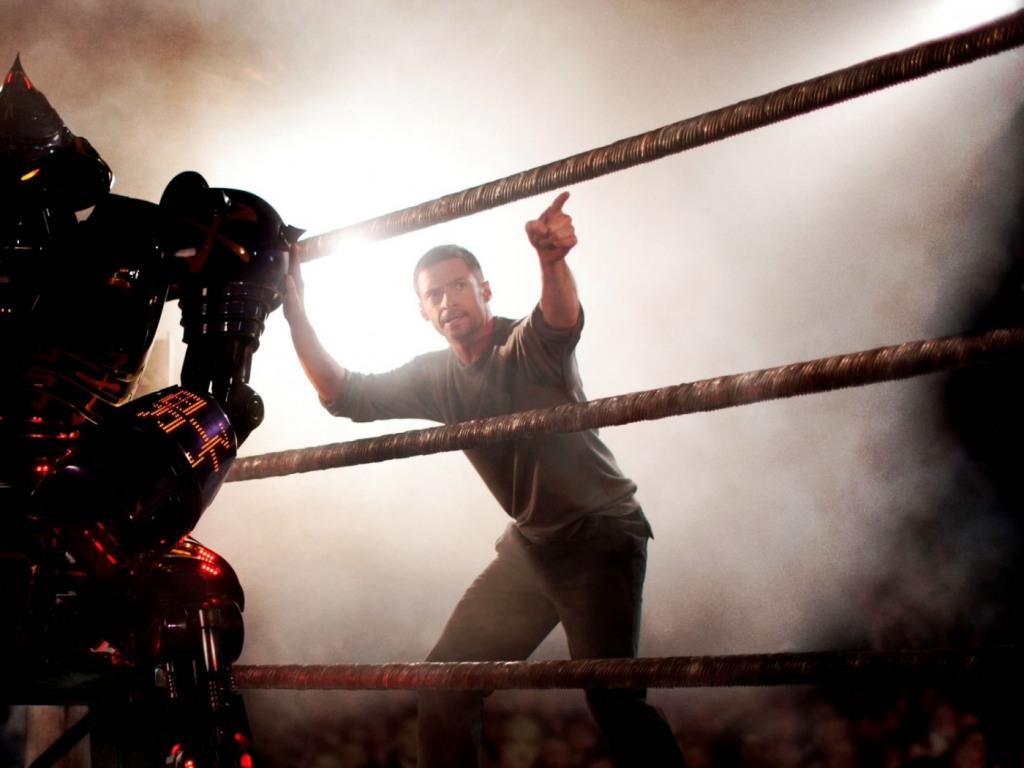“Real Steel” gives us a boxing future where the referee dons padded armor, the ring
girl looks like something out of “Tron” and fighters perspire diesel instead of sweat. This
is because human contenders have been replaced by two-ton robots who duke it out
until theyʼre dismembered or short-circuit. Former prize fighters are now the remote-operators of their own robots who took their place. Ironic.
A futuristic father-son movie
The exact year of this future is not revealed. One character makes the reference “back in 2014” the way we today would say “back in the ‘90s.” Yet aside from these giant robots, not much else in the film is excessively futuristic … a curiously average take on a distant ulterior? I like it. Rarely does Hollywood settle for a future-set story that doesn’t include flying cars or post-apocalyptic landscapes.
Charlie Kenton (Hugh Jackman) is a retired boxer who is down on his luck in the underground world of robot fighting. An opening action scene involving some questionable violence to a thankfully computer-animated bull results in the destruction of Charlieʼs robot. Slinking back to the gym run by Bailey (Evangeline Lily), the daughter of his deceased trainer, Charlie is unexpectedly faced with a revelation: He has a son. An ex-girlfriend he abandoned long ago has passed away and 11-year-old Max (Dakota Goyo) is now placed on his doorstep. At this point it becomes clear that this is a father-son movie in disguise.
Though Charlie and Max show resentment towards one another at first, they
ultimately — not to mention predictably — realize how important they are to each otherʼs
lives. Max is at times irritatingly similar to his father, building on the cliché that is expressed in all of the filmʼs relationships. The sexual and emotional tension between Charlie and Bailey is unnecessary and only exists to fit into Charlieʼs minuscule character development. The villains are rather uninspired and exist simply for the purpose of being bad.
Typical characters and plot
But “Real Steel,” if anything, is consistent and stays true to itself. The dialogue is uniform for a B movie and properly progresses the bonding between Charlie and Max with this future of robotic boxing as a backdrop.
The movie is long, and not needlessly, but the first act is weak. The plot improves considerably with the introduction of the robot named Atom. As a second generation sparring bot, Atom is dismissed by Charlie as a piece of junk, but Max is curiously drawn to him. Atom seems to have something behind his doll-like face and glowing blue eyes. Is it a soul? Some form of will or self-awareness? The film never resolves this, only uses it to promote Atom as a character rather than a hunk of metal that Charlie and Max can control. This sentiment is achieved by the climax, a proper end to any formulaic boxing movie, that is, the final fight as Atom the underdog takes on the world champ.
“Real Steel” is directed by Shawn Levy, who seems to have only dabbled in the
world of comedy-adventure with films like “Night at the Museum” and “Date Night.” Yet
here he duly orchestrates some impressive fighting sequences between CGI robots,
particularly Atomʼs first fight in what appeared to be an abandoned zoo and his last fight,
the “David and Goliath” showdown with the alpha-bot “Zeus” in the grand arena. John Gatins has written a script that starts off slow, picks up in the middle and gives a satisfactory ending undoubtedly intended to evoke tears.
Jackman, who I realize more and more is a notoriously boisterous actor, fills Charlieʼs shoes well. He is grizzled, sarcastic and full of angst but has a heart that Max brings out. Lily is, as always, gorgeous in her little mannerisms that defined her character so well in “Lost,” using a tough girl personality to set herself apart as the hot tomboy-type of a leading lady. Newcomer Goyo plays Max with a confidence and attitude that is rare from other estranged son figures in movies like this.
Leaves unanswered questions
The question I begged the entire length of the film was: why in this future were human boxers replaced? All the money taken and spent on robots and parts is testament to how expensive boxing would be in a reality of bot fighters. When a human is injured, they heal. When a robot is broken it has to be rebuilt at great cost or replaced entirely. And wouldnʼt the military of this future want robots on the front lines instead of underground boxing rings?
These are some of the many questions that will never be answered in a cliché action picture like this. But wouldnʼt it be fantastic if they were? Which leads me to the conclusion that “Real Steel” could have been sharper and better developed in a slew of ways. Perhaps if the same old recycled character interactions, developments and relationships had not been such a key focus, a higher caliber of film could have been achieved. But the fighting is fun to watch and though I had irks with elements of the narrative I found myself cheering for Atom at the end. The little robot that could.







